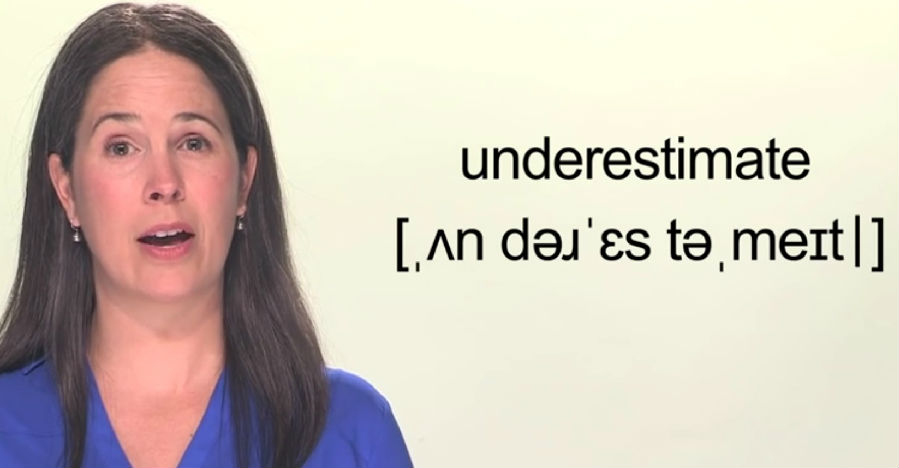In this American English pronunciation video,
在这段美式英语发音视频中,
we’re going to go over how to work on long words.
我们将学习一下如何处理较长的单词。
Multi-syllable words can be really tricky.
多音节单词可能真的很棘手。
There are so many sounds and transitions in them.
长单词里面的声音和过渡太多了。
So today we’re going to talk about how to work on multi-syllable words.
所以今天我们要讨论的就是如何处理多音节单词。
I encourage you to keep a running list of long words that have come up in conversation for you that are hard for you to say.
我建议你长期坚持把会话中出现的那些你很难说出的长单词列在一个清单上。
Maybe they are words that relate to your field of study or work.
也许这些词与你的学习或工作领域有关。
Let’s use as an example the word ‘underestimate’.
让我们以“underestimate”这个单词为例来看一下。
First, look it up in the dictionary and get the IPA.
首先,你需要查字典找到这个单词,然后把它的国际音标抄写下来。
But what I really want to talk about today is, make sure you know what syllables are stressed.
但我今天真正想说的是,你要确保自己知道哪些是重读音节。
This is a five-syllable word with stress on the middle syllable.
这是单词一共有五个音节,中间第三个音节需要重读。
There is secondary stress in this word, marked by the little line at the bottom.
这个单词有次要重读音节,底部画有一条小横线。
I’m going to say, don’t worry about that.
我要说的是,你其实不必担心次重读音节。
They’re more like unstressed syllables than stressed syllables.
和重读音节相比,次要重读音节更像是非重读音节。
Let’s start by just practicing the stressed syllable. Es.
让我们从练习重读音节开始。Es。
Do you know the shape of a stressed syllable?
你知道重读音节的形状吗?
I made a video a long time ago about how the voice should curve up and then down in a stressed syllable.
很久以前,我制作了一段视频,内容是重读音节中的声音应该如何先向上再向下。
The sounds are the most important in this stressed syllable – they should be the clearest in your word.
重读音节的发音是最重要的,它们应该是整个单词中发音最清晰的音节。
Practice just the stressed syllable using a hand movement,
只练习重读音节,加上手部动作,如果想让单词听起来很自然,
the shape is really important in making the word sound natural. Es, es.
那么形状就至关重要了。E,es。
Maybe even try it in slow motion. Es.
你还可以试一下慢节奏的发音。Es。
Now let’s look at the rest of the syllables. We have two before and two after.
现在我们来看一下其余的音节。重读音节前面和后面各有两个音节。
Practice these syllables together, there’s no need to practice them separately like the stressed syllable.
可以把这些音节放在一起练习,没有必要像重读音节那样单独练习。
First we have ‘under’. These syllables should be really different than the stressed one, es.
首先,我们看“under”里面的音节。这些音节与重读音节es有很大的不同。
Under, under. What’s different? They’re a little quieter, less clear, they don’t have that shape.
Under,under。有什么不同?它们的发音稍微安静一些,不那么清晰,它们没有重读音节那样的形状。
There’s less energy in the voice. Under – es – timate. Two more syllables, also unstressed.
声音里的能量少了很多。Under – es – timate。另外两个音节,也不重读。
under-, -timate. There’s less mouth movement for these unstressed syllables,
under-, -timate。当你读这些非重读音节的时候,嘴巴的动作也会比较少,
isn’t there? under-, -timate. They’re simpler.
你看是不是?under-, -timate。这些音节读起来更简单。
At the beginning of the video, I talked about how long words can be hard
在视频的开头,我说长单词可能会很难,
because there are so many sounds, but I want you to see that in unstressed syllables,
因为长单词包含的发音会很多,但我想让你们明白的是,在读非重读音节的时候,
the sounds don’t have to be fully formed and fully pronounced.
声音不必完全成形或者完全发音。
These sounds are quieter, flatter in pitch, faster, simpler. under-, -timate.
这些音节发音更安静,音调更平缓,速度更快,更简单。under-,-timate。
This should make long words easier, but that doesn’t mean you don’t have to practice them.
这样可以让长单词变得更易读一些,但这并不意味着你不需要练习这些非重读音节。
You do, you need repeat a new word over and over,
实际上你需要练习这些非重读音节,你需要反复地读一个新单词,
but the point is to break it up into simplified and stressed syllables.
但关键是要把它分解成简化的和重读的音节。
Let’s keep working on it: under – es –timate (2x). Underestimate (3x).
让我们继续读这个单词吧:under – es –timate (两遍)。Underestimate(三遍)。
Let’s try another word: inevitable. First, look up the stress.
让我们试试读另一个单词:inevitable。首先,找到重读音节。
The second syllable is stressed, which we know because of the mark before it.
第二个音节是重读音节,我们通过这个音节前面的标记可以得知。
So let’s break it down.
现在让我们把这个单词分解一下。
Ev, ev, ev. In – ev – itable, -itable, -itable, -itable. In – ev – itable. Inevitable (3x).
Ev,ev, ev。In – ev – itable,-itable,-itable,-itable。In – ev – itable。Inevitable(3遍)。
Put together a list of long words and work through them this way.
将长单词列在一个清单中,然后像这样练习掌握这些单词。

I really think that breaking up a word into stressed and unstressed syllables
我十分相信把一个单词分解成重读和非重读音节并重复朗读
is the best way to master it, along with repetition.
是掌握它的最好方法。
The more you get used to the contrast of stressed and unstressed syllables, the better.
你越习惯重读和非重读音节的对比,你就会掌握得越好。
Stress really matters in American English.
重读在美式英语中真的很重要。
If there’s a topic you’d like me to cover, please put it in the comments below.
如果你有什么话题需要我在视频中讲解,可以把话题写在视频下方的评论里。
Also, I’m very excited to tell you that my book is now on sale.
另外,非常高兴地在这里告诉你,我的书现在正在打折。
If you liked this video, there’s a lot more to learn about American English pronunciation,
如果你喜欢这个视频,后续还会有很多关于美式英语发音的知识可以学习,
and my book will help you step by step.
我的书也可以一步一步地帮助你学习发音。
You can get it by clicking here, or in the description below.
您可以通过单击此处或在下面的描述中购买我的书。
That’s it, and thanks so much for using Rachel’s English.
今天的视频就到这里,非常感谢你使用瑞秋英语。


